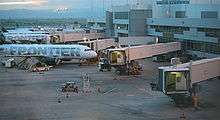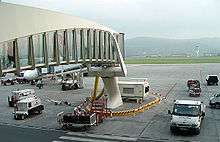Jet bridge

A jet bridge (also termed jetway,[1] gangway, aerobridge/airbridge, air jetty, portal, skybridge or its official industry name passenger boarding bridge (PBB)) is an enclosed, movable connector which most commonly extends from an airport terminal gate to an airplane, and in some instances from a port to a boat or ship, allowing passengers to board and disembark without going outside or being exposed to the elements.[2] Depending on building design, sill heights, fueling positions, and operational requirements, a jet bridge may be fixed or movable, swinging radially and/or extending in length.[2] The jetway was invented by Frank Der Yuen.[3][4]


.jpg)

History
Before the introduction of jet bridges, passengers normally boarded an aircraft by walking along the ground-level ramp and climbing a set of movable stairs, or up airstairs on aircraft so equipped. Mobile staircases or "ramp stairs" are employed at many airports around the world, particularly smaller airports and terminals supporting low cost carriers.
United Airlines tested an early prototype "Air Dock" in 1954.[5] The first operational jet bridges were installed in 1959, although sources disagree as to which airport installed jet bridges first. Some accounts state that the first jet bridge was installed on July 22, 1959 at Hartsfield–Jackson Atlanta International Airport;[6] other accounts place the first jet bridge at Chicago O'Hare International Airport, Los Angeles International Airport, LaGuardia Airport or San Francisco International Airport.[5]
Advantages
Jet bridges provide all-weather dry access to aircraft and enhance the security of terminal operations. They are often permanently attached at one end by a pivot (or rotunda) to the terminal building and have the ability to swing left or right. The cabin, at the end of the loading bridge, may be raised or lowered, extended or retracted, and may pivot, to accommodate aircraft of different sizes.[2] These motions are controlled by an operator's station in the cab. The cab is provided with an accordion-like canopy, which allows the bridge to dock with aircraft with differing shapes, and provide a nearly weather-proof seal. Additionally, many models offer leveling devices for the portion of the floor that makes contact with the aircraft; this allows passengers to slowly transition from level aircraft floor to sloping jet bridge floor. As such, jet bridges provide enhanced access to aircraft for passengers with many types of disabilities and mobility impairments, as they may board and disembark without climbing stairs or using a specialized wheelchair lift.
Some airports with international gates have two or three bridges for larger aircraft with multiple entrances. In theory, this allows for faster disembarking of larger aircraft, though it is quite common, especially on aircraft such as Boeing 747s and Boeing 777s, to use one bridge for only passengers in first class and/or business class, while the other bridge is for the use of passengers in economy class. The Airbus A380 is unique in that both of its double decks have outside doors; so that two or more loading bridges are possible, a jetbridge for each deck having the advantage being faster aircraft loading (in parallel). Such connectors are being constructed at Kuala Lumpur International Airport, Hartsfield-Jackson Atlanta International Airport, Johannesburg International Airport and in the new international terminal at Calgary International Airport. Faster loading can lead to lower airport charges, less delays and more passenger throughput for the airport, all factors which impact an airline's bottom line.
These are already in use at Dubai International Airport, Melbourne Airport, Chhatrapati Shivaji International Airport, Queen Alia International Airport, Sydney Airport, Auckland Airport, Singapore Changi Airport, Toronto Pearson International Airport, Montréal–Pierre Elliott Trudeau International Airport, Incheon International Airport, Beijing Capital International Airport, Hong Kong International Airport, Heathrow Airport, Narita Airport, Indira Gandhi International Airport, Charles de Gaulle Airport, Los Angeles International Airport, San Francisco International Airport, Mexico City International Airport, and Suvarnabhumi Airport with the A380. King Shaka International Airport and Edmonton International Airport have A380 jet bridges but no A380 use them.
Though loading bridges are usually permanently attached at their terminal-building end, leaving only the cab free to move, this is not always the case. Those at Melbourne Airport's international terminal are — and at Hong Kong's old Kai Tak Airport were — anchored in the middle and movable at either end to permit the terminal building-end to be raised or lowered to connect with either the departures level or the arrivals level of the terminal building.
Disadvantages
Loading bridges restrict aircraft parking to spots immediately adjacent to the terminal. Thus, airports use mobile staircases to facilitate disembarking at hardstands (remote parking positions).
Loading bridges may pose hazards to aircraft if handled improperly. If the bridge is not retracted fully before departure, it may contact protruding parts of the taxiing aircraft (e.g., a pitot tube), requiring repair and delays. Furthermore, during cold weather, the loading bridge may become frozen to the aircraft. In this case, when the jet bridge retracts, it could damage the aircraft if that area has not been properly de-iced.
Loading bridges usually cost more to use than remote stands, so many low cost carriers (e.g., Ryanair, Easyjet, and AirAsia) prefer not to use them.
When regional jets are used, jet bridges have another disadvantage, since they only allow one aircraft to park at the gate at a time. Several airlines have removed jet bridges at regional jet gates at airports such as Atlanta which are short on gates. When having passengers disembark on the tarmac or the ramp, airlines can fit two or more regional jets per gate. In many other places like Beijing Capital Airport and Paris Charles de Gaulle Airport, a gate for large aircraft can be used to accommodate two smaller aircraft like Boeing 737s or Airbus A320s.
Several incidents of jet bridges collapsing include Sydney,[7][8] Hong Kong Chep Lap Kok, Seattle and Los Angeles.[9]
Use at small airports
Jet bridges are occasionally used at smaller, single-story airports. This is accomplished by a flight of stairs and, in some instances, a wheelchair lift. In this scenario, a passenger proceeds through the gate and then up a flight of stairs to meet the height of the jet bridge. An example of this can be found at South Bend International Airport in South Bend, Indiana. Alternatively, a ramp can be used in the terminal building to bring the passengers from the waiting area to the height of the jet bridge. For example, Sawyer International Airport, located near Marquette, Michigan in Michigan's Upper Peninsula, has jet bridges that can load passengers onto smaller passenger aircraft such as the Saab 340 turboprop. The Ithaca Tompkins Regional Airport at Ithaca, New York has two gates using this approach. This can be done to attract larger airlines that require use of a jet bridge to the airport, as well as to make disembarking smaller planes easier for disabled people and to improve the disembarking process in bad weather.
Use and appearance

At the airport terminal, the bridge is connected to a portal (called a "gate") in the terminal wall behind the gate desk. Once airplane boarding starts, passengers hand their boarding passes to the gate's attendant, who lets them pass through.
Inside, the bridge looks like a narrow, lighted hallway in an office building, without doors. Loading bridges usually have no windows, but glass walls are becoming more common. The walls are normally painted in accordance with airline standards, generally with relaxing colours. Some bridges have advertisements on interior or exterior walls. The floor is generally uneven with many bumps, creating a hazard for wheelchairs and individuals with mobility issues.
By using a retractable tunnel design, loading bridges may retract and extend varying lengths. Some airports use fixed walkways to effectively extend the reach of a loading bridge. The fixed walkway extends out from the terminal building and connects to the loading bridge rotunda. Occasionally, fixed bridges lead to multiple loading bridges. There are some jetways (such as the ones at Edmonton International Airport and Calgary International Airport) that sit directly on the ground, as opposed to supports. These jetways are often used by small airlines or airplanes that are sometimes too low for conventional jetways (such as the Dash 8 and CRJ).
The cab of the loading bridge is raised and lowered to dock with aircraft of differing sill heights. The height of the cab is matched to the height of the aircraft door sill height. This often results in a slope along the length of the loading bridge.
Controls in older systems contain a large number of individual motor control buttons, with efficient operation requiring a high degree of operator skill and experience. Modern control consoles are much simpler, with only a few buttons, a graphic display console, and a single multi-axis joystick, with an overall appearance similar to that of a video game console in a video arcade.
Marketing
Marketing space on jetways was uncommon until the early 2000s when HSBC launched their campaign "The World's Local Bank.:[10]

Peter Stringham, head of marketing for HSBC worldwide,[11] worked closely with Lowe's, the Group's global agency, in developing the campaign which required a single global platform. Stringham noticed jetways were a global medium which had not been tapped.[12]
HSBC thus bought the rights to jetways across major localities in 81 countries and territories.[13] Hence, the vast majority of advertising on jetways globally display HSBC advertising.
Gallery
-

Adaptation of airport equipment for all-weather ship access, Kobe, Japan
-
Interior of a modern ThyssenKrupp Airport Systems' glass walled bridge at Incheon Airport
-

Glass walled bridge at Adelaide Airport
-

Another similar bridge at Adelaide Airport
-

Jetway at Bilbao Airport in Spain, design by Santiago Calatrava
-
Jetway at Orlando International with ramp equipment below.
-
A short fixed bridge connected to a loading bridge at Sea-Tac Airport
-
Note outboard gantry and driving wheels on a modern ThyssenKrupp Airport Systems' PBB at Incheon Airport
-
Control console
-

Jetway in Turkmenbashi Airport
Oslo Airport viewed from inside a jet bridge. Passenger planes from Norwegian Air Shuttle and Scandinavian Airlines are parked on the airport apron. Distorted panorama photo 2015. |
See also
- Covered bridge
- Ground support equipment
- Mobile lounge
- Moveable bridges for a list of other moveable bridge types
References
- ↑ Justia/trademarks The term Jetway is a registered trademark
- 1 2 3 Gesell, Laurence E. (1992). The Administration of Public Airports. Chandler, Arizona: Coast Aire. pp. 114–115. ISBN 0-9606874-7-5.
- ↑ Burl Burlingame (2013). I'll Fly to Hawaii — A century of Aviation. Pacific Monograph. p. 135. ISBN 9780962922763.
- ↑ US 3046908, Der Yuen Frank, "Apparatus for facilitating the loading and unloading of passengers and cargo", published Jul 31, 1962
- 1 2 Baskas, Harriet (25 February 2016). "A short history of the much-maligned jet bridge". USA Today. Retrieved 1 March 2016.
- ↑ Steve Smith (17 April 2013). "Just Where Was That First Boarding Bridge Installed?". Aviationpros. Retrieved 8 December 2015.
- ↑ "Investigations begin into collapse of Sydney airport walkway". 2001-02-01. Retrieved 2013-01-09.
- ↑ "NSW: Singapore Airlines jet damaged when aerobridge collapses". 2001-02-01. Retrieved 2013-01-09.
- ↑ "2 injured when jet bridge collapses at LA airport". Associated Press. 2011-08-25. Retrieved 2013-01-09.
- ↑ World's Global Bank
- ↑ New Campaign for World's Global Bank
- ↑ Pandey, Rayana (2012-02-07). "Marketing, HSBC: The World's Local Bank no more, GLOBAL, ADVERTISING, Campaigns, Branding, Brand reputation, Competitions, | Market-interactive.com". Marketing-interactive.com. Retrieved 2013-06-29.
- ↑ Seeb, Eric (2012-02-26). "HSBC Different Points of View Campaign | UW Marketing 555". Marketing555.wordpress.com. Retrieved 2013-06-29.
External links
| Wikimedia Commons has media related to Jet bridges. |